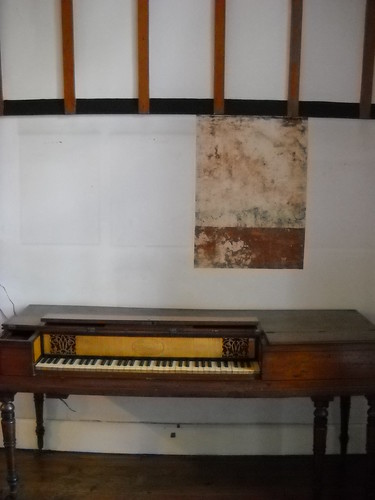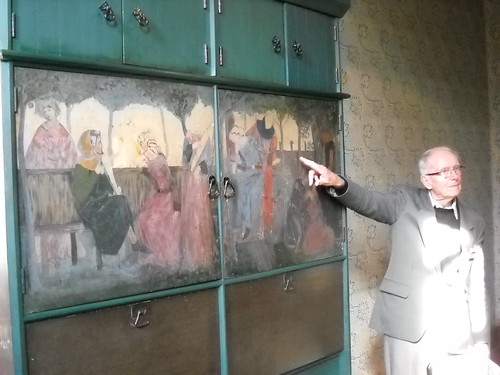When I bought the house the walls had been painted white and the whole place was rather cold and lifeless. In my giddy, uneducated, new homeowner state, I bounced down to the paint store where I was introduced to a whole new world in the form of the Arts and Crafts color palette. There were actually paint chips in colors common to the Craftsman home of the 1910's and '20s, with names inspired by nature like 'Acorn Yellow', 'Bark', 'California Redwood', 'Sage'. I was like a kid in a candy store!
I started looking through design magazines focused on Craftsman homes for ideas and decided on a few different colors: a sagey green for the living room, a warm glowing chamois for the dining room, two shades of lavender for the bedroom, and a spicy paprika-like color for the office that changed from chocolate-raspberry in dark corners to a rusty red in the light. Armed with a can of olive green paint and a brush, I started in the inglenook. That was the day the house came alive.
 |
| Traditional Craftsman colors |
On either side of the fireplace were twin stained glass windows. The windows had been painted shut and the colors of the flower motif in the glass were drab. But the second I added the olive paint to the walls, they dazzled! It was as if the house was opening it's eyes after a long slumber. When the painting was finished the rooms no longer felt cold, they felt warm and homey. I have loathed the glaring starkness of bare white walls ever since.
Little did I know that the Arts & Crafts Movement began over 150 years ago in a little suburb of London called Bexleyheath. William Morris built a house here, and it is he who started the decorating and textile craze that became Arts & Crafts, almost by accident. His philosophy spilled into the garden, too, and examples of the Arts & Crafts Garden style can be seen in English gardens at Great Dixter, Sissinghurst, Hidcote, and the homes of fellow bungalow owners in California.
Imagine my curiosity when I learned I would be visiting Morris's Red House with my Historic Garden Conservation class, and envisioning the colorful interior. Imagine my dismay when I stepped inside and saw bare white walls!
They weren't always that way, I learned. The National Trust only recently acquired The Red House in 2003 and it was a previous owner who white-washed the original warmth of the walls away. The heathens!
 |
| The pianoforte in the upstairs living room, with a section of the original wall color revealed. |
 |
| Our tour guide, pointing out the portraits of family and friends painted by Morris on this settle in the front hall |
 |
| Painted glass window in the side hall done by Morris's friend, artist Edward Burne-Jones |
 |
| "Fate and Love" |
Another sin committed by the previous owners was to cover up William Morris's wall decor in the upstairs living room with white paneling. I noticed the paint chipped edges of a section of paneling and wondered what that was about when the tour guide explained and opened the panels to reveal a colorful flower motif behind. Had they no shame!?
In an upstairs bedroom hidden behind a closet is a faded wall painting began by Elizabeth Siddal, the wife of Dante Gabriel Rossetti. Depicting a woman in sad repose, it's a far cry from the gaily painted nymph on the closet door of the child's room at Charleston House, but you get the sense that the entire wall painting would have told a story, not to mention livening up the room, and I was curious to know what that story was or would have been (Elizabeth died before the painting was finished).
Viewing the interior of the house brought to mind the same questions we face when considering the conservation of an historic garden. While the Red House is famous because of William Morris, there were other owners and occupants during the house's history, and the law of the land gave them the right to make whatever changes they wanted (grumble, grumble). So the dilemma faced by every conservationist is whether to maintain, repair, restore, or conserve. And when you're talking about historical layers, which one do you choose?
In my own house I chose to keep the faded pink and blue bathroom tile because it was in good condition, felt retro, and was cost-prohibitive to replace. One might argue the upgrade is a good representative of the type of "updates" that were commonly made to old houses in the 1950's, and should be maintained as a sample of '50s decor. A purist would restore back to the original. In the case of the Red House, I lean toward purity and originality. The Red House is billed as the home that was designed and built for William Morris, founder of the Arts and Crafts Movement, yet the interior does not represent his design philosophy. I would guess that most people familiar with his designs expect to see them covering the walls of his home, not the stark whiteness that glares at you when you enter. In that respect, I would argue in favor of restoring the interior by removing the white paint. Perhaps it's too costly? Perhaps since the National Trust only recently acquired the house, it's on their to-do list?
Indeed, the only part of the place where I could approve of changes made by previous owners was in the garden, which was enlarged from Morris's day yet retains a continuity and character that is fitting with the style of the house. And there's a cat! I heartily approve of cats in the garden!
On a side note, and as a demonstration of just how much life color adds to a place, here's a photo of some rather unexpected gifts bestowed upon me by my classmates for taking on a beast of an editing job for a group project. I wasn't expecting anything in return, but the flowers are doing a wonderful job of cheering my dismal little student cell, greeting me with their smiles and flirty petals when I return from a long slog in the library. Possibly my favorite thing about it is the fact that I don't have a vase and had to put the flowers in my cafetiere - look how great the colors work together! The small painting is an oil pastel of a garden conservatory by my god-brother.
It just goes to prove what Morris said:
All rooms ought to look as if they were lived in, and to have so to say, a friendly welcome ready for the incomer. ~William Morris








No comments:
Post a Comment